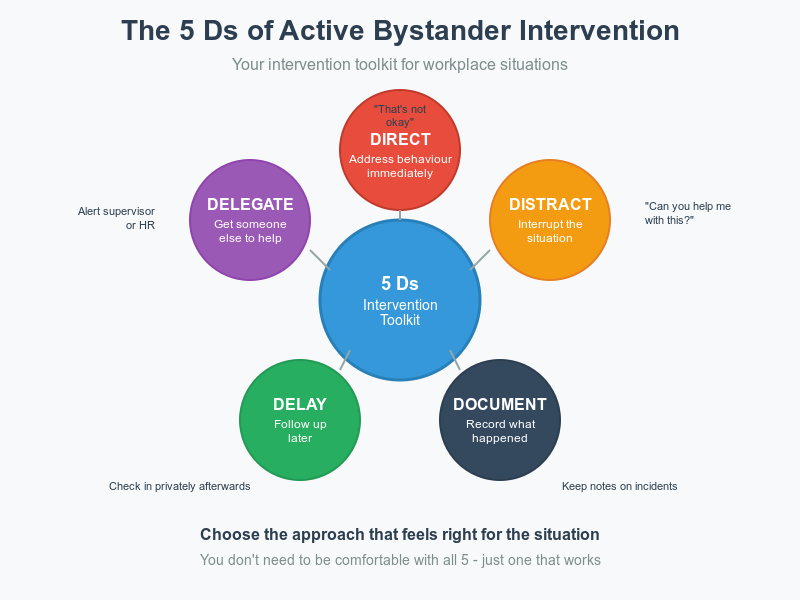Your toolkit for workplace intervention
So there’s this colleague I know who completely froze when his boss made a racist comment during a team meeting.
Afterwards, he came to me and said, “I wanted to say something but had no idea what. Do I call him out in front of everyone? Do I report it to HR? Do I pretend it didn’t happen? I just sat there like an idiot.”
Sound familiar? Most people want to do the right thing when they witness inappropriate behaviour, but they get paralysed because they don’t know what their options are. That’s where the 5 Ds come in.
The 5 Ds are basically your intervention toolkit. Direct, Distract, Delegate, Delay, and Document. Five different ways you can respond when you witness something dodgy at work. The beauty is you don’t have to be comfortable with all of them. You just need one or two that work for your personality and the situation.

This framework didn’t come out of nowhere either. Started with something called the Three Ds back in 2012, developed by an organisation called Green Dot. Then it got expanded to include Delay in 2015, and Document got added in 2017. So it’s been tested and refined over more than a decade of helping people figure out how to be effective bystanders.
The whole point is giving people options. When you only have one way to respond and that way feels too scary or inappropriate for the situation, you end up doing nothing. But when you’ve got five different approaches? Much more likely you’ll find one that feels doable.
Start your online course here or contact us here.
The first D: Direct intervention
Direct intervention is exactly what it sounds like. You address the inappropriate behaviour head-on, right there in the moment.
Sounds terrifying, right? But honestly, it’s often not as dramatic as people think.
Direct intervention can be as simple as saying “That’s not okay” in a calm voice. Or “I don’t think that’s funny.” Or “That comment makes me uncomfortable.” You’re not launching into a lecture about workplace harassment policy. You’re just clearly communicating that the behaviour is inappropriate.
The key with direct intervention is picking your moments. It works best when you feel physically and emotionally safe, when you have equal or higher status than the person behaving inappropriately, and when you think your words might actually make a difference.
I’ve seen direct intervention work brilliantly in situations where someone makes an inappropriate joke and a colleague just goes, “Not cool, mate.” Short, clear, no drama. Often the person making the joke will back down immediately and the conversation moves on.
But you’ve got to assess the situation first. Direct intervention with your boss when they’re already in a foul mood? Probably not your best bet. Direct intervention when there’s a power imbalance or you’re worried about retaliation? Maybe try one of the other Ds.
The thing about direct intervention is it sends the clearest possible message to everyone present. It tells the person behaving inappropriately that their behaviour isn’t acceptable. It tells the target that someone’s willing to stand up for them. It tells other bystanders that intervention is possible and appropriate.
When it works, it’s incredibly effective. The behaviour usually stops immediately, and it often doesn’t happen again because the person knows someone will call them out.
But it’s not always the right choice, and that’s perfectly fine. That’s why we’ve got four other options.
The second D: Distract
Distraction is probably my favourite of the 5 Ds because it’s so bloody creative.
The idea is to interrupt the inappropriate behaviour by creating a distraction that derails what’s happening. You’re not directly confronting the person behaving badly. You’re just changing the dynamic of the situation.
Classic distraction techniques include asking the target for help with something (“Sorry to interrupt, but can you help me figure out this client brief?”), creating an interruption (“Has anyone seen my notes from yesterday’s meeting?”), or redirecting the conversation (“Speaking of the quarterly review, when are we getting those results?”).
I’ve seen people use some brilliant distractions. Someone pretending they’re lost and asking the target for directions. Someone spilling water “accidentally” to create a commotion. Someone asking a completely unrelated question that forces everyone to shift focus.
The beauty of distraction is it often doesn’t even register with the person behaving inappropriately that they’ve been challenged. They just get interrupted and the moment passes. But for the target, it provides immediate relief and extraction from an uncomfortable situation.
Distraction works particularly well when you’re not sure if what you witnessed actually crossed a line, but something felt off. You don’t have to make a judgment call about whether behaviour was definitely inappropriate. You just create space for the target to extract themselves.
It’s also brilliant when there’s a power imbalance. If your boss is making inappropriate comments to a junior colleague, direct intervention might feel too risky. But distraction? Much safer option that still provides immediate support to the person being targeted.
The key with distraction is timing and naturalness. You want your interruption to feel organic, not obviously contrived. And you want to give the target an easy way to engage with your distraction so they can gracefully exit the uncomfortable situation.
Start your online course here or contact us here.
The third D: Delegate
Delegation is about recognising when someone else is better positioned to address the situation than you are.
This isn’t about passing the buck or avoiding responsibility. It’s about strategic thinking. Sometimes you’re not the right person to intervene directly, but you know someone who is.
Maybe you witnessed inappropriate behaviour from a senior manager and you’re quite junior in the organisation. Direct intervention feels risky, distraction didn’t work, but you know their peer or their boss would take the issue seriously. That’s when delegation makes sense.
Or maybe you saw something happen to a colleague who you don’t know very well, but you know they have a good relationship with someone else on the team who could provide better support.
Delegation might look like alerting a supervisor about what you witnessed. Or connecting the affected person with HR resources. Or asking a colleague who has a stronger relationship with the person behaving inappropriately to have a word with them.
The important thing is making sure you’re delegating to someone who actually has the ability and willingness to address the situation appropriately. Don’t just dump the problem on the first person you think of. Think about who’s most likely to take effective action.
Sometimes delegation is about recognising your own limitations too. Maybe you witnessed something but you’re not sure if it was serious enough to warrant intervention. Talking it through with someone more experienced can help you figure out next steps.
Or maybe you tried one of the other Ds and it didn’t work, so you need to escalate to someone with more authority or different skills.
The key with delegation is follow-up. Don’t just hand the problem over and wash your hands of it. Check in to make sure appropriate action was taken. Be available to provide additional information if needed.
The fourth D: Delay
Delay gets a bad rap sometimes because people think it’s just another word for doing nothing. But that’s not what it means at all.
Delay is about recognising that immediate intervention isn’t always possible or appropriate, but that doesn’t mean you can’t take action later.
Maybe you witnessed inappropriate behaviour in a context where any of the other Ds would have been risky or ineffective. Big client meeting where causing a scene would reflect badly on your organisation. Public setting where you were concerned about escalating the situation. Moment when you were genuinely shocked and couldn’t think of an appropriate response.
That’s when delay comes in.
Delayed intervention might look like checking in with the person who was targeted after the meeting. “Hey, are you okay after what happened in there? That comment was completely inappropriate.” Simple acknowledgment that what they experienced wasn’t okay and offering support.
It might look like having a private conversation with the person who behaved inappropriately. “I wanted to talk to you about that comment you made earlier. It came across as sexist and made several people uncomfortable.”
Or it might look like reporting the incident through appropriate channels when you have time to think through the best approach.
The thing about delayed intervention is it’s often more thoughtful and strategic than immediate responses. You have time to consider the best approach, seek advice if needed, and choose your moment carefully.
Delayed intervention is also crucial for providing ongoing support to people who’ve experienced inappropriate behaviour. Just because the moment has passed doesn’t mean the impact has. Checking in with targets, offering resources, advocating for them in future situations – all forms of delayed intervention that can make a huge difference.
Don’t feel guilty if you didn’t intervene immediately. Delayed action is still action, and it’s often more effective than rushed immediate responses.
The fifth D: Document
Documentation sounds really formal and intimidating, but it doesn’t have to be.
Sometimes it’s just keeping notes about what you witnessed, when it happened, who was present. Basic information that might be useful later if the situation escalates or patterns emerge.
Documentation serves heaps of purposes in workplace contexts. It creates records that can support formal processes if needed. It helps identify patterns of behaviour over time. It provides evidence if situations end up requiring HR intervention or legal action.
But documentation also needs to be done thoughtfully, especially around privacy and consent.
If you’re documenting something that happened to someone else, think about whether they’d want that incident recorded. Sometimes people prefer to handle things privately and don’t want formal records created. Other times, documentation provides important protection and validation.
Good documentation includes date, time, location, who was present, what specifically happened (using actual words where possible rather than interpretations), and any immediate responses or consequences.
Keep it factual rather than emotional. Instead of “John was being a complete arsehole to Sarah,” write “John interrupted Sarah three times during her presentation and told her she was ‘getting too emotional’ when she tried to finish her points.”
Store documentation securely and think carefully about who you share it with. The goal is creating useful records, not spreading gossip or violating people’s privacy.
Documentation becomes particularly important when you’re seeing repeated patterns of behaviour. One inappropriate comment might be addressed through direct intervention or distraction. But five inappropriate comments over six months? That’s a pattern that needs formal attention, and documentation helps make that case clearly.
Sometimes documentation is the only intervention that feels safe or appropriate in the moment, but it can lead to more significant action later.

Choosing the right D for different situations
The magic of the 5 Ds is having options. Different situations call for different approaches, and different people are comfortable with different intervention styles.
Heaps of factors influence which D makes sense in any given moment. Your relationship with the people involved. The severity of the behaviour. The power dynamics at play. The context where it’s happening. Your own comfort level and skills.
Someone who’s naturally confrontational might default to direct intervention. Someone who’s more reserved might prefer distraction or delay. Someone in a leadership position might feel comfortable with delegation. Someone who’s detail-oriented might gravitate toward documentation.
The important thing is not forcing yourself into intervention styles that don’t fit your personality or the situation. If direct intervention feels way too scary, don’t beat yourself up about it. Try distraction instead. If you missed the moment for immediate intervention, delay is still a valid option.
I’ve also noticed people often combine multiple Ds. They might use distraction in the moment to provide immediate support, then follow up with delayed intervention to address the behaviour more thoroughly. Or they might try direct intervention and then document what happened in case further action is needed.
The beauty of having five different approaches is it massively increases the likelihood that you’ll find one that feels doable. And once you start intervening regularly, you’ll probably find your comfort zone expands. Someone who starts with documentation might gradually feel more confident with distraction or direct intervention.
What matters is taking some form of action rather than staying passive. Even if your intervention doesn’t work perfectly, you’ve sent important messages about what behaviour is and isn’t acceptable in your workplace.
Putting the 5 Ds into practice
Understanding the 5 Ds is one thing. Actually using them when you witness inappropriate behaviour is something else entirely.
I’ve seen people go from complete bystander paralysis to confident intervention once they understood they had options and got some practice using them. But it does take practice. And it helps enormously when your workplace culture supports bystander intervention rather than discouraging it.
The best way to build your skills with the 5 Ds is through scenario-based training where you can practice different approaches in safe environments. Role-playing different workplace situations, discussing what intervention options might work best, getting feedback on your approach.
But you can also start small in your current workplace. Look for lower-stakes opportunities to practice intervention skills. Maybe someone makes a mildly inappropriate joke in a small group setting. Perfect chance to try out direct intervention or distraction without massive consequences if it doesn’t go perfectly.
The more you practice, the more natural it becomes to assess situations quickly and choose appropriate intervention strategies.
Organisational support makes a huge difference too. When leadership clearly values bystander intervention and protects people who speak up appropriately, it creates psychological safety for using the 5 Ds effectively. When policies explicitly support bystander action and provide clear escalation pathways, people feel more confident about intervening.
Look, the 5 Ds aren’t magic. They’re tools. But they’re bloody effective tools when you know how to use them and when you’ve got support for using them.
If you want to build your skills with the 5 Ds and become a more confident active bystander, there are practical steps you can take right now. Check out our online training here for comprehensive skill development you can do at your own pace, or contact us about live training that gives you hands-on practice with real workplace scenarios.
Remember, being an active bystander isn’t about being perfect or fearless. It’s about having a toolkit of intervention options and the confidence to use them when it matters. The 5 Ds give you that toolkit.
Start your online course here or contact us here.








